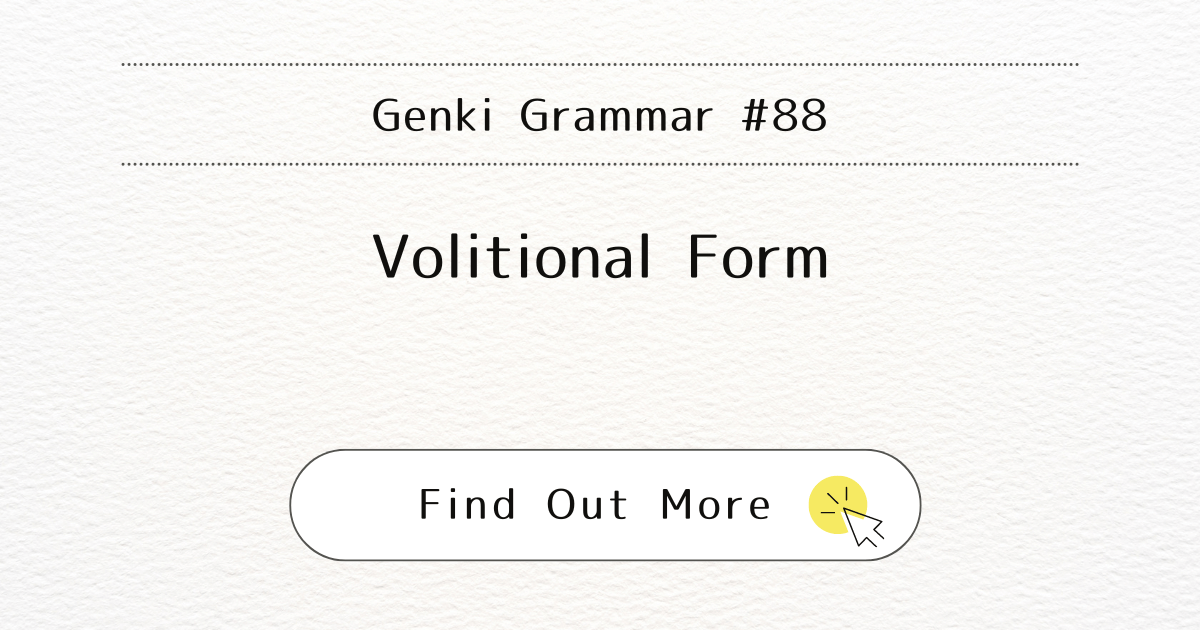
Introduction
In Japanese, the volitional form is a casual way to suggest doing something together, similar to the polite ましょう (mashou). This blog post will explain how to form the volitional form and how to use it in conversation.
What It Means
The volitional form is a casual equivalent of ましょう and is used to suggest a plan or action. It’s like saying “Let’s do something” or “Shall we?” in English. The volitional form is less formal and is often used in friendly, informal settings.
How to Form the Volitional
You can create the volitional form using the following rules:
1. Ru-verbs: Drop the final -ru and add -you.
- 見る (miru) → 見よう (mi-you)
Let’s watch.
2. U-verbs: Drop the final -u and add -ou.
- 行く (ik-u) → 行こう (ik-ou)
Let’s go. - 話す (hanasu) → 話そう (hanasou)
Let’s talk. - 待つ (matsu) → 待とう (matou)
Let’s wait. - 読む (yomu) → 読もう (yomou)
Let’s read. - 作る (tsukuru) → 作ろう (tsukurou)
Let’s make. - 泳ぐ (oyogu) → 泳ごう (oyogou)
Let’s swim. - 遊ぶ (asobu) → 遊ぼう (asobou)
Let’s play. - 買う (kau) → 買おう (kaou)
Let’s buy.
3. Irregular Verbs:
- くる (kuru) → こよう (koyou)
Let’s come. - する (suru) → しよう (shiyou)
Let’s do.
Think of the u-verb conjugation in terms of the hiragana chart, where the final -u sound changes to -ou.
| 行 | 話 | 待 | 死 | 読 | 作 | 泳 | 遊 | 買 | ||
| negative | か | さ | た | な | ま | ら | が | ば | わ | -ない |
| stem | き | し | ち | に | み | り | ぎ | び | い | -ます |
| affirmative | く | す | つ | ぬ | む | る | ぐ | ぶ | う | ≡Dictionary form |
| potential | け | せ | て | ね | め | れ | げ | べ | え | -る |
| volitional | こ | そ | と | の | も | ろ | ご | ぼ | お | -う |
When You Use It
The volitional form is great for suggesting plans with friends or offering help. You can also combine the volitional form with the question particle か (ka) to ask for someone’s opinion or to propose a plan.
Examples
Here are some examples of how to use the volitional form:
Making Plans:

来週は授業がないから、どこかに行こう。(Raishuu wa jugyou ga nai kara, dokoka ni ikou.)
We won’t have classes next week, so let’s go somewhere.

いいね。そうしよう。(Ii ne. Sou shiyou.)
Sounds good. Let’s do that.
Offering Help:

手伝おうか。(Tetsudao ka?)
Shall I lend you a hand?

ううん。大丈夫。(Uun. Daijoubu.)
No, I’m okay.
Proposing a Plan:

今度、いつ会おうか。(Kondo, itsu aou ka?)
When shall we meet again?

来週の金曜日はどう?(Raishuu no kinyoubi wa dou?)
How about Friday next week?
Note
The volitional form is informal, so it’s best used among friends, family, or in casual situations. If you need to be more formal, stick with ましょう.
Conclusion
Mastering the volitional form will help you sound more natural when making plans or offering help in Japanese. It’s a useful tool for everyday conversations with friends and family.



